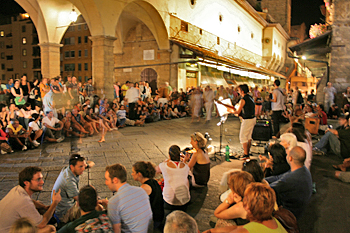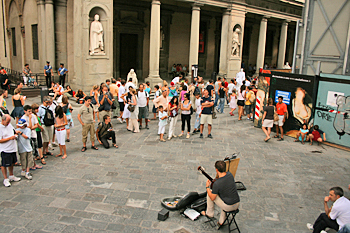Usually, when I arrive in a new city I am very excited by it. I see all the good things about it and think, this would be a great place to live. Then I spend a few days walking around and start to see its blemishes. By the time I have seen all the major sites I am ready to leave – glad I have come but knowing this is not a place I could ever live. Fighting the incessant, unruly crowds to see the sites in Venice and Rome thoroughly wore me out. So the thought of going to yet another culture and art-filled Italian Renaissance town was enough to gag me. But I stuck to my plan to visit Florence, knowing I would kick myself later if I scratched it off the list.
The Eurostar express train traveled through the Tuscan countryside, with its tiny hilltop towns, arriving in Florence less than two hours after departing Rome. I dragged my suitcase and backpack the four blocks to my hotel and, after getting a bite to eat at a restaurant down the block, fell into bed and slept like a dead person. The next morning, with very little enthusiasm, I set out to discover Florence.



I started with the church that everyone wants to see in Florence, Santa Maria Del Fiore Cathedral, more commonly referred to as Il Duomo because of its giant dome. This cathedral is breathtaking in both size and design. In front is the circular Baptistry of John the Baptist, with its enormous carved brass doors. Beyond the Baptistry sits the Cathedral, a white, pink and green marble monolith backed by a giant dome, and its matching Campanile (bell tower).


I groaned when I saw that the dome could be climbed, knowing I am obsessive enough that I would not let this opportunity pass me by. Up I went on worn marble steps that end in a narrow spiral staircase barely wide enough for one person. It is the only way up or down, so I was constantly caught in a crush of people who had to press together in some niche and wait for the descending people to push past. When I finally got to the top, I was less than enthralled. I gazed down at yet another sea of red tile-roofed houses and churches that could have been any of the other Italian towns I have visited. So far, I was not impressed.
But then I began to wander Florence’s streets and piazzas. I began with a street leading to Ponte Vecchio, the only bridge in town that was not destroyed during World War II. Over the years, shops were built on the bridge span, cantilevering out over the water to gain more selling space. The result is a hodge-podge of construction, each shop painted a slightly different warm Tuscan color, with three ancient arches in the very center of the bridge that still allow views of the Arno River.




In past years these shops were blacksmiths, dry goods stores, and others that served the community, but over the years they have morphed into tourist trade. Today the Ponte Vecchio is famous for its jewelry stores that specialize in gold and deep blue lapis lazuli. The crowds on the street leading up to the Ponte Vecchio were massive, as were the crowds on the bridge itself, but just a few steps down the riverbank they dissipated. I found the real delight of the bridge to be in viewing it from slightly afar during the daytime and up close at night, when it becomes a venue for musicians and the crowds are not so bad.


Around the corner from the Ponte Vecchio lies the Piazza de la Signoria, the large square that is the heart and soul of Florence. Piazza de la Signoria is the home of Palazzo Vecchio. This palace was the private home of the Medici family until they were ousted from Florence, at which point it became the seat of the Italian Parliament at a time when Florence was the capitol of Italy. At the hands of the Medici, the square was decorated with sculpture, including Michelangelo’s famous state of David, which initially stood at the entrance to the palace.

Although the sculpture of David that stands in the Piazza is a copy (it now stands in the Uffizi Museum) museum, the Piazza is still a veritable open air sculpture garden. A large fountain of Neptune and Tritons stands at its center and numerous other free-standing sculptures are scattered around the square, including one of Bacchus, God of wine and feasts, and another of Perseus holding aloft the severed head of Medusa.



Behind the palace is a U-shaped building, originally constructed by the Medici to house their administrators and subsequently used as government offices. Today, in keeping with the art tradition at Piazza de la Signoria, this building houses the famous Uffizi Art Gallery.
I was so enthralled with this Piazza that I returned on my second day to tour the interior of Palazzo Vecchio. The entrance fee of 8 Euros (about $10 US) was money well spent. Entering through the giant foyer, the self-guiding tour begins in the massive Great Hall, with its giant oil murals depicting the history of Florence, its intricately painted ceiling, and its collection of marble sculptures by Michelangelo and Di Rossi. Computer stations are scattered around this hall, providing virtual tours that explain the history of the Florence and the part that the palace and the square played in it. Placards throughout the palace explain the history and design of each room. Every room was astonishing – every inch of the walls, floors and ceilings were covered in mind-boggling designs or artwork.





Late in the afternoon I left the palace and spent another few hours loitering in the square, enjoying a coffee and caramel Gelato on the steps of the Uffizi as I listened to a classical guitarist and watched the antics of a pantomime artist.

As you might expect, Florence is all about history, Baroque and Renaissance art, and culture. But, as evidenced by the following photos, it’s about so much more…








At the end of my second day in Florence I strolled back to the hotel along the banks of the Arno River at 11:30 PM, having just enjoyed a concert at the Ponte Vecchio. It is said that for every action there is an equal and opposite reaction and that is what has happened to me in Florence. Unlike other cities, which fade in their attraction, Florence has grown on me and I find I really like this city. This is some place I could easily live.

You did a great shots! You just took them from the best angle!
yes especially of the couple!! soo. cute.
Beautiful Firenze! I’m happy that you like it. Just to let you know I am still having coffee with your blog. Great photos. I think I like the lovers best! Seems like that is what Florence is all about. And now? Lisboa? I think you’ll love that also. Happy Trails as the end is near. Or rather the beginning of a new adventure for you. Ellie